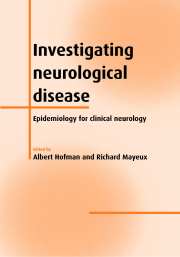Book contents
- Frontmatter
- Contents
- List of contributors
- Preface
- Part I Quantitative methods in clinical neurology
- 1 Clinical research design: analytical studies
- 2 Genetic epidemiology in neurologic disease
- 3 Gene–environment interaction in neurologic disorders
- 4 Analysis, reanalysis, and meta-analysis in neurology
- 5 Diagnostic research in clinical neurology
- 6 Decision analysis in clinical neurology
- 7 Outcomes research in clinical neurology
- 8 Survival analysis in neurological diseases
- 9 The clinical trial in efficacy research in neurological diseases
- Part II Neurological diseases
- Index
3 - Gene–environment interaction in neurologic disorders
from Part I - Quantitative methods in clinical neurology
Published online by Cambridge University Press: 29 September 2009
- Frontmatter
- Contents
- List of contributors
- Preface
- Part I Quantitative methods in clinical neurology
- 1 Clinical research design: analytical studies
- 2 Genetic epidemiology in neurologic disease
- 3 Gene–environment interaction in neurologic disorders
- 4 Analysis, reanalysis, and meta-analysis in neurology
- 5 Diagnostic research in clinical neurology
- 6 Decision analysis in clinical neurology
- 7 Outcomes research in clinical neurology
- 8 Survival analysis in neurological diseases
- 9 The clinical trial in efficacy research in neurological diseases
- Part II Neurological diseases
- Index
Summary
Introduction
In the past decade considerable progress has been made in unraveling the etiology of important major genetic diseases including neurogenetic disorders such as Huntington disease and autosomal dominant forms of Alzheimer's disease. At present, genetic research focuses on common neurologic diseases including Alzheimer's disease, Parkinson's disease, stroke and multiple sclerosis. Although it will be far more difficult to uncover the genetics of these complex disorders, as the Human Genome Project and molecular technology advances, the chances of success appear to be high. The pathogenesis of these disorders is more complex in that multiple genetic and environmental factors may interact. For the purpose of research as well as clinical practice, a key issue to resolve will be the interaction of genetic and environmental factors. In this chapter, the basic concept of gene–environment interaction will be discussed including the definition and principal mechanisms. Further, the evidence for gene–environment interaction will be addressed. Finally, some critical considerations for future research will be given.
Definition
Gene–environment interaction may be defined in several ways. From the perspective of a neurogenetic disorder, gene-environment interaction implies that the risk of disease associated with mutations or common genetic variations (i.e., polymorphisms) in genes is altered by a nongenetic risk factor. It is important to realize that in the case that an environmental factor causes a mutation, e.g., radiation leading to germ-line and/or somatic mutations, this does not imply there is evidence for interaction. In most cases it may be solely the mutation that determines the risk of disease without any interference of the environmental factors in the disease pathogenesis.
Keywords
- Type
- Chapter
- Information
- Investigating Neurological DiseaseEpidemiology for Clinical Neurology, pp. 21 - 25Publisher: Cambridge University PressPrint publication year: 2001

